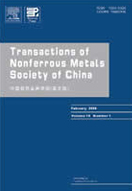Apparent activation energy for spontaneous combustion of
sulfide concentrates in storage yard
sulfide concentrates in storage yard
(1. School of Resources and Safety Engineering, Central South University, Changsha 410083, China;
2. National Research Center of Safety Science and Technology for Metal Mines,
Central South University, Changsha 410083, China)
2. National Research Center of Safety Science and Technology for Metal Mines,
Central South University, Changsha 410083, China)
Abstract: In order to evaluate the spontaneous combustion hazard of sulfide concentrates in storage, three different kinds of sulfide concentrates (sulfur-rich sulfide concentrate, iron sulfide concentrate and copper sulfide concentrate) were obtained from a storage yard in Dongguashan Copper Mine, China. The reaction processes at different heating rates of 5, 10, 15, 20, and 25 °C/min in air flow from ambient temperature to 1 000 °C were studied by TG-DTG-DSC analysis. By the peak temperatures of DTG curves, the whole reaction process for each sample was divided into different stages, and the corresponding apparent activation energies were calculated by the Ozawa-Flynn-Wall method. It is found that the reaction process of each sample is considerably complex; the apparent activation energy values change from 36 to 160 kJ/mol in different temperature ranges; sulfur-rich sulfide and iron sulfide concentrates have lower apparent activation energy than copper sulfide concentrate below 150 °C; so they are more inclined to cause spontaneous combustion at ambient temperature.
Key words: apparent activation energy; sulfide concentrates; spontaneous combustion; thermogravimetry (TG) analysis; differential scanning calorimetry (DSC)

